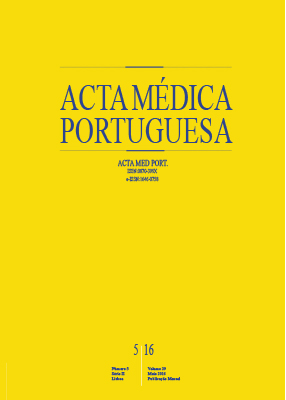Hospital Mortality in Parkinson’s Disease: Retrospective Analysis in a Portuguese Tertiary Centre
DOI:
https://doi.org/10.20344/amp.7070Keywords:
Hospital Mortality, Hospitalization, Parkinson Disease/mortality, Portugal.Abstract
Introduction: Parkinson’s disease is associated with high hospital mortality. Male gender, late age at onset, higher disability and the coexistence of cognitive impairment or depression have been suggested to be risk factors of death. Pneumonia and cardiovascular diseases are the leading causes of death.
Objective: To characterize the mortality (causes of hospital admission and death) of Parkinson’s disease patients in a tertiary hospital, as well as demographic and clinical characteristics.
Material and Methods: Identification of hospital admissions of Parkinson’s disease patients that resulted in inpatient death between 2008 and 2014. Retrospective review of medical files and inclusion of patients with disease clinically confirmed by a neurologist. Assessment of causes of death and demographic and clinical characteristics of patients.
Results: 1525 hospital admissions of Parkinson’s disease patients were identified, of which 150 resulted in death. Of these, 52 patients met the inclusion criteria. Mean age at onset of Parkinson’s disease symptoms was 66.8 years (± 8.7) and mean duration of disease was 12.5 years (± 7.9). Sixty-five percent of patients were in stages 4-5 of the Hoehn and Yahr scale. Thirty-three patients (63%) had dementia and eleven (21%) had depression. Infections were the leading cause of death (respiratory in 63% of cases).
Discussion: Similarly to literature, pneumonia was the leading cause of hospital death and most patients presented advanced disease stage and dementia. Contrarily to other studies, life expectancy was not reduced and cardiovascular diseases and trauma were not causes of death in our population.
Conclusions: This is the first Portuguese mortality study in Parkinson’s disease. Pneumonia is the leading cause of death. Advanced disease stage and dementia were common features in these patients.
Downloads
Downloads
Published
How to Cite
Issue
Section
License
All the articles published in the AMP are open access and comply with the requirements of funding agencies or academic institutions. The AMP is governed by the terms of the Creative Commons ‘Attribution – Non-Commercial Use - (CC-BY-NC)’ license, regarding the use by third parties.
It is the author’s responsibility to obtain approval for the reproduction of figures, tables, etc. from other publications.
Upon acceptance of an article for publication, the authors will be asked to complete the ICMJE “Copyright Liability and Copyright Sharing Statement “(http://www.actamedicaportuguesa.com/info/AMP-NormasPublicacao.pdf) and the “Declaration of Potential Conflicts of Interest” (http:// www.icmje.org/conflicts-of-interest). An e-mail will be sent to the corresponding author to acknowledge receipt of the manuscript.
After publication, the authors are authorised to make their articles available in repositories of their institutions of origin, as long as they always mention where they were published and according to the Creative Commons license.









